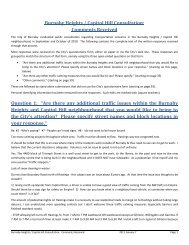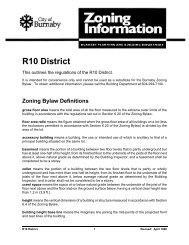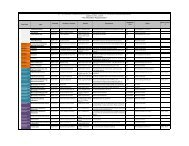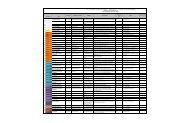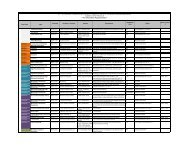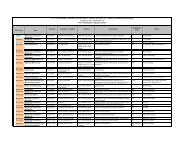Infill Housing - Be a Good Neighbour - City of Burnaby
Infill Housing - Be a Good Neighbour - City of Burnaby
Infill Housing - Be a Good Neighbour - City of Burnaby
You also want an ePaper? Increase the reach of your titles
YUMPU automatically turns print PDFs into web optimized ePapers that Google loves.
Building<br />
Information<br />
BURNABY BUILDING DEPARTMENT<br />
<strong>Infill</strong> <strong>Housing</strong> - <strong>Be</strong> a <strong>Good</strong> <strong>Neighbour</strong><br />
The purpose <strong>of</strong> this brochure is to provide contractors, builders and<br />
homeowners with information and ideas on what infill builders should do as<br />
Agood neighbours@, and what local residents should expect from an infill<br />
project.<br />
“This information is provided for convenience only and is not in substitution <strong>of</strong> applicable <strong>City</strong> Bylaws or Provincial or<br />
Federal Codes or laws. You must satisfy yourself that any existing or proposed construction or other works complies<br />
with such Bylaws, Codes or other laws."<br />
By following some <strong>of</strong> the practices set out in this brochure a builder can make<br />
sure that his or her project creates the most benefits for the neighbourhood<br />
with the least possible disruption. <strong>Be</strong>ing a considerate builder is good<br />
business practice.<br />
See List <strong>of</strong> Other Brochures related to this topic at the end <strong>of</strong> this<br />
document.<br />
<strong>Infill</strong> <strong>Housing</strong><br />
As cities grow and change so do neighbourhoods. For a variety <strong>of</strong> reasons old homes are torn<br />
down only to be replaced with a new and <strong>of</strong>ten larger building. This process <strong>of</strong> building new homes<br />
in already established neighbourhoods is Ainfill housing@. A single-family dwelling need not be<br />
replaced with another single-family dwelling on that lot. It can in fact be replaced by a duplex or<br />
involve the putting up <strong>of</strong> townhouses or simply be a major addition or renovation to an existing<br />
home.<br />
The Problem<br />
An infill project traditionally impacts on an established neighbourhood in a variety <strong>of</strong> ways.<br />
Immediate neighbours feel the impact <strong>of</strong> the new larger building being placed closer to the property<br />
lines and the disruption <strong>of</strong> equipment and workers immediately adjacent to their home. Other<br />
neighbours throughout the neighbourhood may be impacted by the changes to the streetscape, the<br />
removal <strong>of</strong> trees, and the noise and dirt <strong>of</strong> the construction.<br />
<strong>Infill</strong> <strong>Housing</strong> 1 Revised: 2010 July 27
Many <strong>of</strong> the negative impacts <strong>of</strong> an infill development can be mitigated by the builder if time is taken<br />
to keep local residents properly informed <strong>of</strong> his or her plans, the site is kept clean and safe, and<br />
certain other basic steps are taken to ensure that the development will be a safe and acceptable<br />
one.<br />
Guidelines for a Successful <strong>Infill</strong> Project<br />
C Make sure you have all required approvals and permits:<br />
C Talk to the neighbours. Tell them what you are doing:<br />
C Protect the neighbourhood including other property such as trees, shrubs and fences:<br />
C Clean up after yourself:<br />
C Keep noisy work to allowable times:<br />
C Do not block driveways (public or private).<br />
Permits and Approvals<br />
Every development project must receive <strong>City</strong> approval (building permit, subdivision, rezoning, etc.)<br />
before the work can start. If the proposal does not comply with the <strong>City</strong>=s Zoning Bylaw an<br />
application must be made to rezone the property, or for minor variance, to the Board <strong>of</strong> Variance.<br />
Never start construction until all the necessary approvals have been received. If you do you may be<br />
liable for substantial fines and/or have to remove or redo any or all <strong>of</strong> the work you have already<br />
completed.<br />
Builders and developers should consult with <strong>City</strong> Building and Planning staff well in advance to<br />
determine if the project meets all <strong>of</strong> the <strong>City</strong>=s requirements.<br />
Rezoning, Subdivision or Consolidation<br />
Many infill projects will require rezoning or Board <strong>of</strong> Variance approval. If the project meets the<br />
general intent <strong>of</strong> the <strong>of</strong>ficial community plan but not the Zoning Bylaw (e.g.: higher density or<br />
different use than allowed in the bylaw) the builder can apply to the <strong>City</strong> for a Zoning Bylaw<br />
amendment. This includes public information, consultation with affected agencies, and a public<br />
meeting.<br />
If the proposed development requires the subdivision <strong>of</strong> a large lot to create two or more smaller<br />
lots, or if the project involves the consolidation <strong>of</strong> a number <strong>of</strong> lots to create a larger parcel for the<br />
development <strong>of</strong> a townhouse or strata complex, then the developer should undertake preliminary<br />
meetings with the Planning Department at the very earliest stages <strong>of</strong> the project.<br />
Demolition<br />
Most infill projects require the demolition <strong>of</strong> one or more existing building. Applicants for demolition<br />
permits for single or two-family dwellings must submit a tree plan with their application for a permit.<br />
They must also provide pro<strong>of</strong> <strong>of</strong> ownership or a letter <strong>of</strong> permission to demolish the building(s) from<br />
the property owner. The applicant for demolition permit should be familiar with all on-site<br />
conditions. They should contact the Land Title Office for information regarding all easements,<br />
<strong>Infill</strong> <strong>Housing</strong> 2 Revised: 2010 July 27
ights-<strong>of</strong>-way and covenants. They should also arrange for the safe disconnection <strong>of</strong> all utilities and<br />
the removal <strong>of</strong> hazardous materials prior to demolition, and should be familiar with Part 8 <strong>of</strong> the B.C.<br />
Building Code which is titled ASafety Measures at Construction and Demolition Sites@. Dust, noise<br />
and debris should be minimized during demolition and the work should be undertaken at a time<br />
which will not have a negative impact on the harmony <strong>of</strong> the neighbourhood.<br />
Building Permit<br />
A building permit is required for all new construction, exterior renovations or additions, pools,<br />
chimneys, house moves, temporary buildings/structures, demolitions, interior finishing, renovations<br />
and accessory buildings. Home owners, agents, designers, or contractors may apply for a building<br />
permit by submitting two sets <strong>of</strong> working drawings to the <strong>City</strong>=s Building Department. A building<br />
permit must be obtained prior to issuance <strong>of</strong> any electrical, plumbing and gas permits that may be<br />
required to complete construction.<br />
For information on the application procedure for a building permit please call 604-294-7130.<br />
Other Applicable Laws<br />
Construction projects must also conform to other provincial regulations and city bylaws. The<br />
Workers= Compensation Act covers a wide variety <strong>of</strong> issues, from safety helmets and boots to<br />
property protection, to proper shoring <strong>of</strong> trenches. <strong>City</strong> bylaws regulate a variety <strong>of</strong> issues including<br />
fence height, construction noise, road cleaning, signs, and tree protection. The disposal <strong>of</strong><br />
demolition material and construction waste is regulated both by city bylaws and provincial acts.<br />
Drywall is to be adequately disposed <strong>of</strong> by recycling or an acceptable disposal site. For more<br />
information on the disposal <strong>of</strong> construction waste please see the Building Department=s Building<br />
Information brochure entitled A Management and Disposal <strong>of</strong> Construction Wastes@.<br />
Contractors and building crews should be aware <strong>of</strong> local parking regulations and should not block<br />
lanes or streets for extended periods <strong>of</strong> time.<br />
Any pertinent city bylaws can be obtained from the Clerk=s Office at <strong>Burnaby</strong> <strong>City</strong> Hall, 4949<br />
Canada Way, <strong>Burnaby</strong>, BC V5G 1M2 or from the <strong>City</strong> website at www.city.burnaby.ca<br />
Talk to the <strong>Neighbour</strong>s<br />
<strong>Be</strong>fore making application for a building permit, minor variance, rezoning or subdivision, builders<br />
should inform nearby residents what is being planned by writing a letter or visiting them personally.<br />
When neighbours have full information they are usually much more supportive and understanding <strong>of</strong><br />
the project.<br />
It is <strong>of</strong>ten useful for the builder to give the neighbours a sheet with his or her full name, address and<br />
phone number. In this way neighbours can contact the builder immediately if they have concerns,<br />
or if there is an emergency.<br />
Prior to the project beginning, a sign should be erected at the site, giving the builder=s full name and<br />
phone number. Signs may be purchased from the Greater Vancouver Home Builders= Association.<br />
<strong>Infill</strong> <strong>Housing</strong> 3 Revised: 2010 July 27
Protect the Property and the <strong>Neighbour</strong>hood<br />
Vacant homes waiting for demolition should not be allowed to become an eyesore or a potential fire<br />
hazard. They should be properly secured to prevent the entry <strong>of</strong> children and animals and<br />
dangerous materials such as broken glass, garbage and abandoned equipment should be removed<br />
from the site as soon as the house becomes vacant. Ideally a house should be vacant only a very<br />
short period before it is ultimately demolished or moved from the site.<br />
Existing neighbourhood services should not be damaged or disrupted. <strong>Be</strong>fore any excavation or<br />
digging call BC ONE CALL at 1-800-474-6886, cellular *6886 or 604-257-1940 to locate any<br />
underground services.<br />
Protect neighbouring properties’ trees and plants. Special care must be given to keep construction<br />
and operations and trucks away from neighbour=s landscaping. Trees and shrubs to be protected<br />
should be circled with protective fencing. If areas are at risk, builders should work out an<br />
acceptable agreement with the homeowner before starting work. Trees on the city boulevard must<br />
be protected and cannot be cut down or damaged without city approval.<br />
Excavations should be fenced to eliminate access by children, and where possible access to the<br />
ongoing construction site should be restricted.<br />
Portable lavatories should be located well away from neighbouring homes. This is particularly<br />
important in the summer months when people will be out in their yards and gardens.<br />
Do not encroach on the neighbour=s property with garbage bins and do not burn construction waste<br />
on the site. All outdoor burning is prohibited in the <strong>City</strong> <strong>of</strong> <strong>Burnaby</strong>.<br />
Make sure your workers are protected. Insist on proper protective equipment such as hard hats<br />
and work boots.<br />
Keep parking access and laneways clear for use by neighbours and emergency vehicles.<br />
Site Maintenance<br />
Prompt clean-up <strong>of</strong> scraps and construction garbage keeps the site from becoming a safety hazard<br />
and an eyesore. Remove mud and dirt tracked onto city streets and sidewalks. If mud does<br />
become a serious problem vehicles should be hosed down before leaving the site. As necessary,<br />
roads should be immediately swept down.<br />
Care must be taken to keep debris on the site. Mud, silt and contaminants must not enter the storm<br />
drainage system.<br />
Failure to comply with these guidelines could result in bylaw action and fines.<br />
Hours <strong>of</strong> Construction<br />
The <strong>Burnaby</strong> Noise Bylaw allows construction to take place between 7:00 a.m. and 8:00 p.m.<br />
<strong>Infill</strong> <strong>Housing</strong> 4 Revised: 2010 July 27
Monday through Friday and from 9:00 a.m. to 8:00 p.m. on Saturdays. On Sundays and statutory<br />
holidays an owner or occupier may personally or through a contractor carry on renovations,<br />
alterations, additions or repairs to a structure in a single or two-family residential district between<br />
the hours <strong>of</strong> 9:00 a.m. and 8:00 p.m. This exemption does not apply to commercial projects or the<br />
construction <strong>of</strong> new houses or buildings. No other construction is permitted on Sundays or statutory<br />
holidays. For additional information about noise control in the <strong>City</strong> <strong>of</strong> <strong>Burnaby</strong> please call the<br />
Engineering Department at 604-294-7460.<br />
Other Considerations<br />
Occasionally a builder or developer will discover that a principle building, from an adjoining lot, is<br />
encroaching on the property that they wish to develop. Such encroachments will not prohibit the<br />
owner or developer from building a new building but, for the purpose <strong>of</strong> applying the spatial<br />
separation requirements <strong>of</strong> the BC Building Code, the encroaching building will be considered to be<br />
a second building on the property. Those spatial separation requirements will be applied to both<br />
the existing and proposed construction.<br />
The <strong>City</strong> does not generally concern itself with aerial encroachments such as gutters, eaves, ro<strong>of</strong><br />
overhangs, bay windows, architectural features, and they should be resolved at the discretion <strong>of</strong> the<br />
adjoining property owners. For more information on encroachments see the Building Department=s<br />
brochure entitled AEncroachments@.<br />
Lateral support for adjoining property is also <strong>of</strong>ten an issue in infill developments. Builders who<br />
excavate a site such that it reduces the grade in relation to adjoining properties should be prepared<br />
to construct a retaining wall or other landscape feature that will provide adequate lateral support for<br />
the neighbour=s property. While <strong>City</strong> bylaws do not address this issue, builders who excavate a site<br />
and cause the neighbour=s property to fall away, or be damaged may be liable to the neighbours to<br />
recover the costs <strong>of</strong> repairing or supporting their property.<br />
Further Information<br />
For further information on building permits please contact the Building Department at 604-294-<br />
7130.<br />
For zoning and planning information please contact the <strong>City</strong>=s Planning Department at<br />
604-294-7400.<br />
For information on encroachments onto easements or public property contact the <strong>City</strong>=s Engineering<br />
Department at 604-294-7460.<br />
The general number for <strong>Burnaby</strong> <strong>City</strong> Hall is 604-294-7944.<br />
<strong>Infill</strong> <strong>Housing</strong> 5 Revised: 2010 July 27
Other Brochures related to this topic<br />
The <strong>City</strong> <strong>of</strong> <strong>Burnaby</strong> Building Department has brochures on a variety <strong>of</strong> related topics available at<br />
their counter. The following are just some <strong>of</strong> the brochures that might be <strong>of</strong> interest to an infill<br />
developer or builder.<br />
C Board <strong>of</strong> Variance appeals<br />
C Building Near Streams and Ravines<br />
C Building permit application requirements for new single and two-family dwellings<br />
C Encroachments<br />
C Foundation and surface drainage installation guide<br />
C Legal survey requirements single and two-family dwellings<br />
C Management and disposal <strong>of</strong> construction wastes<br />
C Permits and inspections for house construction<br />
C Residential parking areas and driveways<br />
C Rock pits<br />
C Ro<strong>of</strong>/Floor Truss Layout<br />
C Selecting contractors for new home renovations and repairs<br />
C Tree bylaw 1996<br />
C Accessory buildings<br />
C Front yard requirements<br />
C Permitted floor area<br />
Q:\Brochures-Bulletins & Zoning Information\Brochures\Current\<strong>Infill</strong> <strong>Housing</strong> - <strong>Be</strong> a <strong>Good</strong> <strong>Neighbour</strong>\<strong>Infill</strong>-Brochure.doc<br />
<strong>Infill</strong> <strong>Housing</strong> 6 Revised: 2010 July 27






